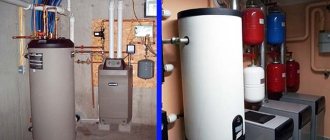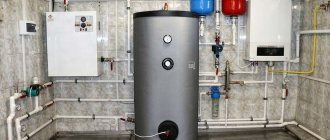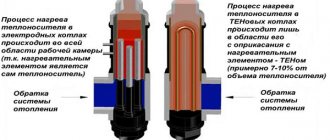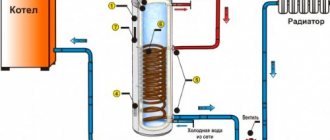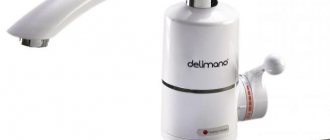Why do you need to clean your boiler?
If there is an odor in the water from the boiler, microorganisms are most likely to blame. The ideal environment for them is humidity and warmth. And this is enough in a storage water heater. They also often accumulate near the heating element, where sediment from poor-quality water remains.
Scale forms mainly on the heating element and the surrounding area. It is dangerous to human health. If you are going to drink water from the boiler. But even if the water is used only for domestic needs, there is no point in deluding yourself.
Lime deposits and metal have different expansion coefficients. Therefore, the heating element wears out due to constant on and off cycles. Scale also prevents the efficient transfer of heat to water, reducing the useful power of the water heater.
Water + anode = hydrogen sulfide
An unpleasant odor from the boiler may appear due to the specific composition of the water. If there is a high concentration of sulfates, they react with the magnesium anode and hydrogen sulfide is released.
This is not difficult to determine - unscrew the heating element and disconnect the anode. After this, return the heating element to its place. If the water no longer smells like rotten eggs, the reason has been found.
There are two options to solve the problem. The first is to use a boiler without a magnesium anode. But in this case, the tank will corrode under the influence of salts and the service life of the water heater will decrease. Corrosion can only be resisted by treating the tank with heat-resistant enamel.
The second option is to install a Zinc, aluminum or titanium anode. They do not react with sulfates and do not emit hydrogen sulfide.
Flushing the boiler without removing it
There are several ways to descale your boiler. It is impossible to say which one is more effective - it all depends on the quality of the water and the substances it contains. You may have to try them all. These methods will also help to flush an indirect heating boiler.
Method No. 1 - citric acid
You will need a large amount of citric acid, at the rate of one 20-gram sachet per liter of boiler volume. For example, a 50-liter water heater will require 0.8 kg of citric acid.
Actually, the procedure:
- Dilute citric acid in a ratio of 1 to 3 with water;
- Pour the resulting mixture into the boiler through the water supply hose;
- Connect the hose to the water pipe;
- Turn on the boiler and wait until it is completely filled;
- Set the maximum temperature and wait until the water heats up;
- Drain the water.
Method number 2 - vinegar
To clean, you will need vinegar or 70% vinegar essence. If you use regular 9% vinegar, you will need 100 ml for each liter of boiler volume.
If you use 70% essence, then you need 13 ml for each liter of boiler volume. For a 50-liter bottle you need to take 650 ml of essence. But before use, dilute it in 2-25 liters of plain water.
How to descale a boiler with vinegar:
- Pour vinegar or essence solution through the water supply hose;
- Connect the hose to the water supply and completely fill the boiler;
- Turn it on to maximum temperature;
- Wait until it warms up completely and leave it like that for 30-35 minutes;
- Drain the water.
Method number 3 - baking soda
To descale your water heater, you will need baking soda (NaHCO3) in the amount of 25 grams per 1 liter of tank volume. It must be completely diluted in water in a ratio of 1 to 12 at a temperature not exceeding 55 degrees. If the baking soda gets hotter, it will decompose.
Usage:
- Pour the soda solution into the boiler through the water supply hose;
- Turn on the water heater, wait until it fills;
- Set the temperature on the regulator to 55 degrees and wait for the water to heat up;
- After the water has warmed up, leave the boiler on for an hour;
- Drain the water.
How to clean a boiler methods
There are two ways to clean a heating device from corrosion products and mineral deposits:
- Without taking it apart;
- With dismantling the housing and removing the heating element.
Cleaning heating devices without dismantling the housing
is a less effective means of combating scale than washing and removing the heating element. In order to clean the water heater without damaging the fastening, it is necessary to sequentially perform a series of operations given below.
- Release the inlet pipe from the connecting fittings;
- Drain 70% of the water from the storage tank through the mixer (approximately 2/3 of the volume);
- Prepare a cleaning solution from citric acid or vinegar, you can also use special formulations following the manufacturer’s instructions;
- Attach a flexible hose to the inlet pipe, the second end of which is fixed above the middle of the storage tank;
- Pour the prepared solution into the water heater through a flexible hose;
- After this, resume the centralized cold water supply and completely fill the boiler.
- Connect the power supply and carry out control heating for 6-8 hours;
- Shut off the water supply to the installation and drain the used cleaner through the hot tap of the mixer.
- Rinse the tank with cold water.
Using this cleaning method allows you to reduce the effect of scale on the heat exchange process, thereby increasing the heating rate and reducing energy consumption. Despite all the advantages, this method does not allow visual assessment of the condition of the heating element and magnesium anode.
Cleaning the water heater by removing the heating element
involves dismantling the storage tank and carefully processing the heating element and the inner surface of the tank. This cleaning method is more labor-intensive, but more effective. Cleaning and collection are carried out in the following sequence:
- The water heater is disconnected from the power supply system;
- The cold water supply is cut off;
- The existing liquid is drained through the hot tap of the mixer or by another method provided for by the connection diagram to the water supply;
- The device is disconnected from the main pipelines;
- The heater is removed from the wall mounts and installed on a special lining or rag.
The further cleaning process is carried out in accordance with the design features of the boiler. In particular, in order to clean the Ariston electric water heater from scale, you need to perform the following operations sequentially:
Cleaning the heating element
- Disassemble the front panel of the control unit;
- Carefully remove the heating element from the tank;
- To clean the heating element of an electric water heater, to do this:
- Using a knife or metal plate, carefully remove large scale deposits. In some cases, the desired effect can be achieved by pressing with pliers;
- Use fine-grained sandpaper to remove any remaining deposits and rinse the product under running water.
- Clean the internal walls of the tank from plaque and deposits;
- Reassemble the installation in reverse order.
In addition to the mechanical method, you can clean the Thermex boiler from scale using ready-made cleaning products or homemade compositions. In this case, the heating element is processed as follows:
- Prepare the solution according to the instructions on the package, or from improvised means (recipes for preparing a cleaner from citric acid or vinegar are given above).
- Immerse the heating element in the resulting solution for 24 hours. If there are particularly persistent deposits, it is allowed to heat the acid bath over low heat to a temperature of 45-500C for half an hour.
- Rinse the heating element in clean water.
Before installation, the heating element should be thoroughly dried.
Since the internal surface of the drive is covered with a special protective layer, abrasive and mechanical effects on it are extremely undesirable. As a rule, the bulk of lime deposits and corrosion products are concentrated on the surface of the heating element and in the area of the magnesium anode, so the following operations are performed to remove scale.
Cleaning the heating tank
Wipe the walls of the tank with a rag soaked in a cleaning solution;
Rinse the container thoroughly;
Before starting assembly, wait until the drive is completely dry.
After cleaning the heating element and storage tank, the device is assembled, installed on the existing mountings and connected to the centralized water supply system in accordance with the existing circuit.
Cleaning the anode and heating element
The top of the heating element is most likely covered with dirt, which can be easily removed by hand. Underneath there will be a layer of scale (calcium, lime). You'll have to tinker with him.
It is best to remove the outer layer of dirt with a wire brush. knife, etc. But do this carefully so as not to damage the metal of the tube. It’s not that it’s too fragile, but still... When the main contamination has been removed, you can continue cleaning using special means.
Nowadays it is easy to buy a descaling product. Any of them is suitable for heating elements. But the magnesium anode can only be cleaned by hand. To do this, use the same metal brush or sandpaper.
You can finish cleaning a wet heating element using a folk remedy. Place it in a container and estimate how much water you will need to completely cover it. Measure the required volume and add to it:
- Vinegar: 100 ml per 1 liter of water;
- Soda: 50 g per 1 liter of water.
Leave the heating element to soak for a day.
How to fix the problem
If you rarely use the device, then drain the water from the tank while you are away - it will not stagnate. How to drain water from the boiler, read in a separate article.
Periodically you should set the temperature to the highest possible level to allow the contents to warm up thoroughly. High temperature will destroy bacteria.
If the contents still go rotten, you need to clean the internal walls and parts of the case from scale. For this:
- Disconnect the device from the network.
- Drain the liquid.
- Unscrew the fastenings of the heating element flange (if located at the bottom).
- Pull out the heating element. If there is heavy plaque, clean it with a knife, then dip it in a citric acid solution until completely clean.
- How to wash the body? The walls of the tank are washed with a soft sponge and cleaned with a shower. In advanced cases, you need to buy a special anti-scale product. Fill it in the specified ratio with the tank for a while. Then wash off.
It is important to replace the magnesium anode in a timely manner. Modern models have indicators that let you know when it's time to replace them. Otherwise, once every six months you should look under the cover and check the condition of the rod.
For hard water with a high content of impurities, install a filter. How to choose a filter for a boiler, read in a separate publication. They come in different types and operating principles. Periodically, the contents of the flask are replaced.
To completely disinfect the system, an anti-mold agent is added to the filter flask. This cleans both the heater and the pipes. After such cleaning, you need to rinse the device several times with warm water.
Proper operation of equipment allows you to avoid many problems. Therefore, do not be lazy to look at the instructions before turning on the heater. The video will help you keep the device in order:
Cleaning the tank
If there is dirt inside the tank, it can be removed mechanically. That is, wipe it with your hands. Suitable for this:
- Soda;
- Vinegar;
- Lemon acid;
- Detergent.
Cleaning a removed tank is a more reliable and economical way than pouring solutions into it and heating it. You will need very little active substance and a regular sponge or dish brush with a long handle. But remember a few rules:
- If the inside of your boiler is painted with enamel, do not use hard or metal brushes or sponges;
- Perform all work wearing gloves;
- If there is a thick deposit of scale, you will have to install the water heater in place, pour the active substance into the boiler and warm it up;
- If corrosion appears on the inner walls, the best option is to sand it off and paint the tank with enamel.
Causes of unpleasant odor
There are several reasons that lead to the formation of an unpleasant odor from the tank of a heating device. Among the most common are:
- The result of a chemical reaction between magnesium anode and sulfides, resulting in the formation of hydrogen sulfide.
- When the boiler is rarely used, the liquid stagnates and becomes an excellent environment for the development of microorganisms.
- The water in the boiler is heated to a low temperature (40 degrees or less), which also provokes the development of bacteria.
- In the device, water from a well or well is already musty.
- The presence of a large amount of scale on the heating element or the internal walls of the tank.
To eliminate each cause, a specific method is used.
Causes of foul odor
When your boiler water stinks, the causes and methods of eliminating the problem depend on the location of the microscopic organisms that produce hydrogen sulfide. This could be the water heater itself or the water supply system where the water comes from. At the same time, the liquid itself can also cause a stench.
Chemical processes
The chemical reaction of magnesium in the anode and sulfur gives an unpleasant smell of rotten eggs.
If water comes out of your home boiler with an odor, the problem may lie in chemical reactions inside the device. Tap water contains sulfides that react with the magnesium anode located inside the water heater. Due to them, water can begin to produce hydrogen sulfide and provoke the appearance of a rotten smell.
If the problem lies in the material from which the boiler is made, the water will also have a foul odor mixed with gouache, plastic or anise. It produces formaldehyde or phenol - substances hazardous to health that cause headaches and insomnia. They are distinguished by low quality plastic, from which water pipes or the boiler itself are made. This problem must be solved by replacing the pipes or heating device.
The water heater rarely turns on
If the heater is rarely used, the water sits in it for a long time and turns into an ideal environment for the spread of bacteria. The stench is one of the manifestations of their vital activity. The unit must be washed and disinfected as soon as possible. The hose is disconnected from the water pipe and white is poured in there along with ordinary water, then the tap is turned off, the hose is connected to the pipe and the valves are opened. When the water is filled, the heater can be turned on.
It is recommended to flush the boiler at least once every six months, regardless of whether it is in use or not. Even in a switched off appliance, bacterial microflora or scale can form, and the inside of the appliance itself begins to acquire a foul odor.
Heating water to a low temperature
At temperatures up to 40 degrees, microbes actively multiply in the water, and the water begins to smell like a swamp.
If the water in your home boiler stinks, the reason may be that it is not heated sufficiently. Temperatures up to 40 degrees are a favorable environment for bacteria that cause the smell of rotten eggs or swamp inside the device. While the boiler is operating, it is better to allow it to heat up to full power, otherwise it may very soon start to stink.
Presence of hydrogen sulfide component in water
The presence of hydrogen sulfide gives off a special smell of rotten eggs; this substance is most often formed in heaters that are not used regularly. Periodically, the water in it must be consumed. Sometimes microbes can withstand temperatures above +60 degrees, but this does not apply to all bacteria. To eliminate odor, the unit is fully heated to maximum temperature and disinfected using special means.
Lime inside the appliance
Scale may cause a rusty smell.
Scale on the internal surfaces of the appliance, including rubber and iron, often causes an unpleasant stench. It can be removed manually or by washing using special or improvised means. To clean the water heater body and its parts you need:
- Disconnect the heater from the network.
- Completely empty the water tank.
- Disconnect the elements securing the flanges to the heating element.
- Take out the heating element and remove the deposits in it with a knife, lower the mechanism into the solution prepared from citric acid until the scale disappears completely.
- To clean the body, wash the walls with a soft sponge and wash off the dirt under the tap. If the plaque layer is too dense, it is better to use a descaling agent according to the instructions.
In order for the heater to work correctly, you need to change the magnesium anode on time and completely replace parts, if necessary. Many boiler models are equipped with indicator elements that begin to light when it is time to change the part.
Why does boiler water smell like hydrogen sulfide?
The smell of hydrogen sulfide in the boiler may appear due to microorganisms growing in it . They usually appear there if the water heater is not used constantly. Moreover, it is not enough to keep it on - you need to periodically use water.
Some microbes can withstand temperatures above +60, but not all. Try to destroy unnecessary “fauna”. To do this, you can simply heat the boiler to maximum temperature.
If the microbes in the storage water heater are more stable, use chemicals. You can wash it with bleach, chloramine or chlorhexidine - the choice of substances for washing is quite wide.
